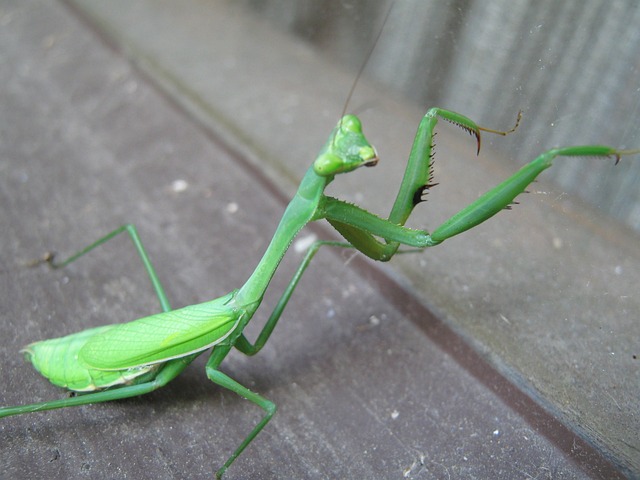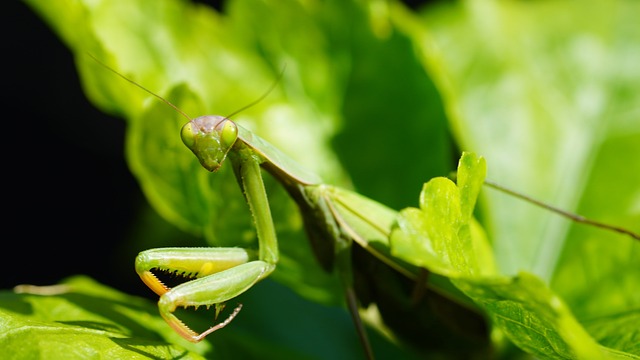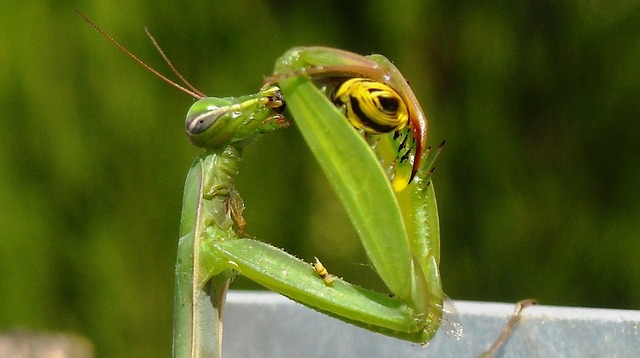The Praying Mantis may seem like a small and harmless insect at first glance, but do not be fooled by its unassuming appearance. This fascinating creature is actually one of nature's most skilled and stealthy predators. With its unique physical characteristics and hunting techniques, the Praying Mantis has captured the fascination and fear of many.
In this article, we will delve into the world of the Praying Mantis, exploring its behavior and role in nature. From its anatomy and physical features to its hunting techniques and reproductive rituals, we will uncover the secrets of this intriguing insect.
We will also address common misconceptions and highlight the positive impact the Praying Mantis has on our environment. Get ready to be amazed by the Praying Mantis, nature's very own stealthy insect predator.

The Anatomy and Physical Characteristics of the Praying Mantis
The Praying Mantis is a fascinating and mysterious insect that has captured the attention of humans for centuries. With its unique physical characteristics and stealthy hunting techniques, the Praying Mantis is often portrayed as a fearsome predator in popular culture. In this section, we will dive deeper into the anatomy and physical features of this insect and explore how they contribute to its abilities as a hunter.
Head: The Praying Mantis has a triangular-shaped head with large compound eyes that give it exceptional vision. These eyes are able to detect movement up to 60 feet away, making the Praying Mantis a highly efficient predator. These compound eyes also have the ability to rotate, giving the insect a 180-degree field of vision without having to move its head. This allows the Praying Mantis to keep a close watch on its surroundings, making it a formidable hunter.
Eyes: The Praying Mantis' unique eyes are not only for impressive vision, but also for camouflage. The insect's eyes have a unique ability to change color, adapting to its surroundings. This allows the Praying Mantis to blend in seamlessly with its environment, making it nearly invisible to its prey. Additionally, the insect's eyes are situated on the sides of its head, giving it a wide field of vision and making it difficult for predators to sneak up on it.
Legs: The Praying Mantis has six legs, each equipped with sharp spines that aid in grasping and holding onto prey. These legs are also incredibly strong, allowing the insect to hold onto larger prey with ease. The front legs of the Praying Mantis are modified into powerful raptorial arms, with sharp spines and hooks that can be used to capture and hold onto prey. These legs are also highly flexible, allowing the insect to quickly strike and catch its prey.
Camouflage Techniques: The Praying Mantis is a master of disguise, using its physical features to blend in with its surroundings and ambush unsuspecting prey. Its body is covered in a combination of green and brown hues, allowing it to camouflage perfectly in foliage and plants. Furthermore, some species of Praying Mantis have unique patterns on their bodies that mimic flowers and leaves, making them almost indistinguishable from their surroundings.
With its distinct head, eyes, and legs, the Praying Mantis is well-equipped for stealthy hunting. Its physical features allow it to blend in with its environment, have excellent vision, and quickly capture prey. These abilities make the Praying Mantis a top predator in its ecosystem, playing a crucial role in controlling insect populations. In the next section, we will explore the hunting techniques and diet of the Praying Mantis in more detail.
Hunting Techniques and Prey of the Praying Mantis
The Praying Mantis is an incredible hunter, known for its stealthy and precise techniques. Its unique physical features and behaviors make it a formidable predator in the insect world.
First and foremost, the Praying Mantis is equipped with a highly specialized head that can rotate up to 180 degrees, giving it a wide field of vision. This, coupled with its large, compound eyes, allows the insect to spot its prey from a distance. Its long and powerful forelegs, also known as raptorial legs, are designed for grasping and holding onto their prey. The Mantis' legs are also covered in sharp spines, giving it a firm grip on its victims.
One of the most fascinating aspects of the Praying Mantis is its ability to blend into its surroundings through camouflage. Its long, slender body and green or brown coloration allow it to blend in perfectly with plants and leaves. This makes the Mantis almost invisible to its prey, giving it the element of surprise. The Mantis can also change its color to match its surroundings, making it even more elusive.
When it comes to hunting, the Praying Mantis is a master of ambush techniques. It remains still and camouflaged, waiting for unsuspecting insects to come within striking distance. Once its prey is within range, the Mantis uses its lightning-fast reflexes to catch and hold onto its victim. Its powerful grasp combined with its sharp mandibles makes it a formidable predator, capable of taking down prey much larger than itself.
But the Praying Mantis is not limited to insects alone. It is known to have a diverse diet, which includes small animals such as lizards, frogs, and even birds. Some larger species of Mantis have been observed catching and consuming rodents and snakes. This makes the Praying Mantis a vital predator in its ecosystem, helping to control insect and small animal populations.
Despite its impressive hunting abilities, the Praying Mantis is not invincible. It has its own predators, such as birds, spiders, and larger insects. However, the Mantis has developed another survival tactic – cannibalism. Female Praying Mantises have been known to eat their male mates during or after mating. This may seem like a bizarre and deadly behavior, but it serves an important purpose. The female gains essential nutrients from consuming the male, making her stronger and better equipped to lay and care for her eggs.
In addition to its unique hunting techniques, the Praying Mantis also has fascinating mating rituals. Male Mantises perform an elaborate dance to court their female counterparts, often involving impressive acrobatic displays. However, this ritual can also be deadly, as the female may turn on the male and eat him if she is not satisfied with his performance.
Contrary to popular belief, the Praying Mantis does not have the ability to turn its head 360 degrees. This is a common misconception, likely due to its flexible neck and large head. However, it does have excellent vision and can rotate its head to a great extent, giving it a wide field of view.
In various cultures, the Praying Mantis holds different meanings and symbolism. In some societies, it is seen as a symbol of patience and stillness, while others believe it has spiritual significance. In some Asian cultures, the Mantis is considered a good luck charm and a symbol of courage.
In conclusion, the Praying Mantis is a stealthy and highly effective predator, crucial to the balance of nature. Its unique hunting techniques, diverse diet, and fascinating behaviors make it a truly intriguing insect. Understanding and appreciating the role of the Praying Mantis in nature can help us appreciate and protect this beneficial and harmless insect.

Reproduction and Mating Rituals of the Praying Mantis
The Praying Mantis is not only a skilled predator, but it also has a fascinating reproductive process that sets it apart from other insects. This process is not for the faint of heart, as it involves cannibalism and a deadly mating ritual. Let's take a closer look at the unique ways in which the Praying Mantis reproduces.
Female Praying Mantises have the ability to reproduce without a male, a process known as parthenogenesis. This means that they can lay fertilized eggs without the need for mating. However, this is not the preferred method of reproduction for Praying Mantises, as it does not result in genetic diversity. This is why the majority of Praying Mantis offspring are produced through sexual reproduction.
During mating season, males will often engage in fierce competition for the attention of a female. This can involve aggressive behaviors such as fighting and even the loss of limbs. Once a male has successfully attracted a female, the mating process begins.
The female Praying Mantis is infamous for her tendency to engage in sexual cannibalism. This means that she will sometimes eat the male after mating. This may seem shocking, but there are actually benefits for both the male and the species as a whole. By sacrificing himself, the male ensures that his genes will be passed on, and the female receives necessary nutrients for egg production.
But not all male Praying Mantises fall victim to their mate. Some species have developed elaborate and deadly mating rituals as a form of courtship. These rituals can involve complex dances and movements, with the male risking his life to impress the female. Some species even have a “love bite” ritual, where the male will gently bite the female's neck before mating.
Despite the risk of being eaten by the female, the mating ritual of the Praying Mantis is essential for the survival and evolution of the species. It allows for natural selection to occur, ensuring that only the fittest and strongest males are able to pass on their genes.
Interestingly, the female Praying Mantis has been observed to practice sexual cannibalism even in the absence of a male. This can be a form of self-mating, where the female will consume her own body parts to provide nutrients for her eggs. This is a remarkable adaptation that allows the species to survive in harsh environments where males may be scarce.
In some cultures, the Praying Mantis is seen as a symbol of fertility and love due to its unique reproductive behaviors. In others, it is seen as a symbol of aggression and danger. However, the Praying Mantis is simply following its natural instincts to ensure the survival of the species.
In conclusion, the reproductive and mating rituals of the Praying Mantis may seem gruesome, but they are essential for its survival. These behaviors have evolved over time to ensure the strongest and fittest individuals continue to pass on their genes. As fascinating as they may be, it is important to remember that these creatures are simply following their instincts and playing a vital role in their ecosystem.
Surprising Facts and Misconceptions about the Praying Mantis
The Praying Mantis is a fascinating and enigmatic insect that has captivated human curiosity for centuries. Its unique physical features and stealthy hunting techniques have earned it a reputation as one of nature's most efficient and deadly predators. However, there are also many misconceptions and surprising facts surrounding this intriguing insect.
Myth #1: The Praying Mantis can turn its head 360 degrees:
One of the most common misconceptions about the Praying Mantis is its ability to rotate its head a full 360 degrees. While it is true that the insect has a remarkable range of motion in its neck, it cannot turn its head all the way around. The Praying Mantis has a flexible neck that allows it to scan its surroundings for prey without moving its body, giving the illusion of a full head rotation.
Fact #1: Female Praying Mantises can reproduce without a male:
Female Praying Mantises have a unique reproductive process that sets them apart from other insects. They have the ability to produce offspring without the need for a male through a process called parthenogenesis. This adaptation allows them to continue the species even when males are scarce or unavailable.
Myth #2: The Praying Mantis is a symbol of death and bad luck:
In many cultures, the Praying Mantis is seen as a symbol of death and evil. This misconception likely stems from the insect's deadly hunting techniques and its habit of engaging in cannibalistic behavior during mating. However, in other cultures, the Praying Mantis is seen as a symbol of good luck, wisdom, and patience. In Chinese culture, the Praying Mantis is even considered a symbol of martial arts and strength.
Fact #2: The Praying Mantis has excellent eyesight:
The Praying Mantis has large, compound eyes that give it a wide field of vision. Its visual acuity is also impressive, with some species able to see objects up to 20 meters away. This keen eyesight allows the insect to spot and stalk its prey with precision, making it an efficient hunter.
Myth #3: Praying Mantises are harmful to humans:
Despite their fearsome reputation, Praying Mantises are actually harmless to humans. They do not have venom or stingers and will only use their sharp forelegs for defense if provoked. In fact, having Praying Mantises in your garden or agricultural fields can be beneficial as they help control pest populations, reducing the need for harmful pesticides.
Fact #3: Praying Mantises have complex mating rituals:
During the mating season, male Praying Mantises will perform elaborate and sometimes deadly rituals to attract a mate. These rituals often involve intricate movements and displays to impress the female. However, in some species, the female may also engage in sexual cannibalism, where she may consume the male after mating. While this may seem gruesome, it can actually be beneficial for the species as it provides the female with much-needed nutrients for egg production.
In conclusion, the Praying Mantis is a truly remarkable insect with many surprising facts and misconceptions surrounding it. From its unique physical features and hunting techniques to its misunderstood symbolism and benefits in nature, the Praying Mantis continues to intrigue and fascinate us. It is a reminder of the incredible diversity and complexity of the natural world and the importance of understanding and protecting these creatures.

The Praying Mantis as a Beneficial and Harmless Insect
The Praying Mantis is a fascinating and mysterious creature that has captured the curiosity of humans for centuries. Despite its fearsome appearance and predatory behavior, the Praying Mantis is actually a beneficial and harmless insect that plays a crucial role in maintaining the delicate balance of nature.
One of the most significant contributions of the Praying Mantis is its role as a natural pest controller. These insects are voracious predators, feeding on a variety of insects and small animals such as crickets, moths, and even small rodents. This makes them valuable allies in gardens and agricultural fields, as they help to keep pest populations in check. Unlike harmful pesticides that can harm other beneficial insects and pollinators, the Praying Mantis is a natural and eco-friendly solution for pest control.
Furthermore, the Praying Mantis is also a crucial player in maintaining the overall health of its ecosystem. By preying on insects and small animals, the Praying Mantis helps to regulate their populations and prevent potential outbreaks. This, in turn, ensures the survival of various plant species and maintains the delicate balance of the food chain.
Contrary to popular belief, the Praying Mantis is not a threat to humans. The fear and misunderstanding surrounding these insects are primarily due to their intimidating appearance and predatory behavior. However, the truth is that Praying Mantises are generally harmless to humans, and cases of them attacking humans are extremely rare. These insects are typically shy and prefer to avoid human interaction, using their excellent camouflage skills to hide and blend into their surroundings.
In fact, the Praying Mantis can even be beneficial for humans in some cultures, where they are considered good luck and symbols of prosperity. In Asian cultures, these insects are seen as symbols of fortune and longevity, while in ancient Greece, they were thought to bring good fortune to farmers. In modern times, the Praying Mantis has become a popular pet, with many people fascinated by their unique appearance and behavior.
Despite their positive contributions, the Praying Mantis population is facing threats due to human activities. The use of pesticides and insecticides in agriculture and urban areas can harm these beneficial insects, leading to a decline in their population. This, in turn, can have a negative impact on the environment, disrupting the natural balance of ecosystems. Therefore, it is essential to raise awareness about the importance of conserving Praying Mantis populations and finding sustainable ways to control pests.
